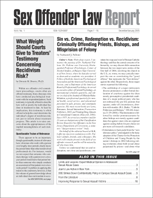Sex Offender Risk Assessment: A Decade of Development, Part II
Author: Mary Jo Breiner, Ph.D..; Philip H. Witt, Ph.D..
Source: Volume 19, Number 03, April/May 2018 , pp.33-37(5)

next article > |return to table of contents
Abstract:
This is the second part of a series begun in Volume 19 Number 2 of Sex Offender Law Report. Part I examined assessments using static versus dynamic risk factors, the value of understanding personality subtypes and their potential to emerge in certain contexts, and the complexities that can be understood in a Risk-Need-Responsivity (RNR) Model. The authors concluded that because RNR recognizes that behavioral learning affects an individual’s cognition, emotion, and the motivational salience of stimuli present in a given situation, RNR contemplates the individual’s history of antisocial behavior within a dynamic analysis. Part II elaborates on the interplay of factors in static and dynamic risk assessments. The authors conclude that the RNR model is best suited to the complex interweaving of factors that sex offenders present for the purposes of assessing risks of recidivism and for designing strategies to treat and manage sex offenders.Keywords: Risk-Need-Responsivity (RNR) Model; Static and Dynamic Factors; Three Offender Prototypes; Risk/Need Factors, Indicators, and Intervention Goals
Affiliations:
1: Florida Department of Children and Families; 2: Rutgers Medical School.